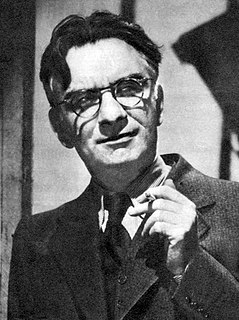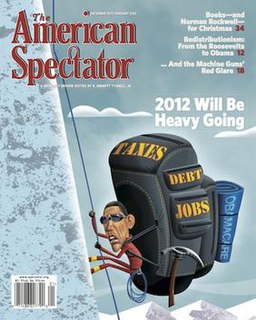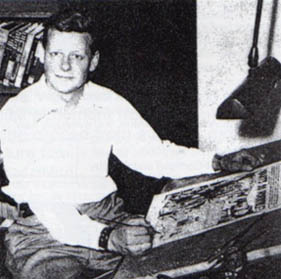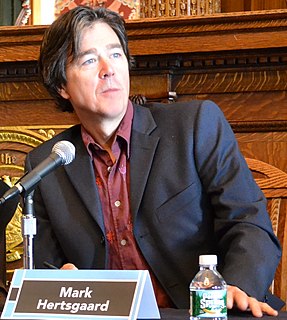
Ernest Miller Hemingway was an American novelist, short-story writer, journalist, and sportsman. His economical and understated style—which he termed the iceberg theory—had a strong influence on 20th-century fiction, while his adventurous lifestyle and his public image brought him admiration from later generations. Hemingway produced most of his work between the mid-1920s and the mid-1950s, and he was awarded the Nobel Prize in Literature in 1954. He published seven novels, six short-story collections, and two nonfiction works. Three of his novels, four short-story collections, and three nonfiction works were published posthumously. Many of his works are considered classics of American literature.

Hunter Stockton Thompson was an American journalist and author, and the founder of the gonzo journalism movement. He first rose to prominence with the publication of Hell's Angels (1967), a book for which he spent a year living and riding with the Hells Angels motorcycle club to write a first-hand account of the lives and experiences of its members.

Rolling Stone is an American monthly magazine that focuses on music, politics, and popular culture. It was founded in San Francisco, California, in 1967 by Jann Wenner, and the music critic Ralph J. Gleason. It was first known for its coverage of rock music and for political reporting by Hunter S. Thompson. In the 1990s, the magazine broadened and shifted its focus to a younger readership interested in youth-oriented television shows, film actors, and popular music. It has since returned to its traditional mix of content, including music, entertainment, and politics.

Joel Chandler Harris was an American journalist, fiction writer, and folklorist best known for his collection of Uncle Remus stories. Born in Eatonton, Georgia, where he served as an apprentice on a plantation during his teenage years, Harris spent most of his adult life in Atlanta working as an associate editor at The Atlanta Constitution.

Thomas Kennerly Wolfe Jr. was an American author and journalist widely known for his association with New Journalism, a style of news writing and journalism developed in the 1960s and 1970s that incorporated literary techniques.

Life was an American magazine published weekly from 1883 to 1972, as an intermittent "special" until 1978, and as a monthly from 1978 until 2000. During its golden age from 1936 to 1972, Life was a wide-ranging weekly general interest magazine known for the quality of its photography.

James Mallahan Cain was an American author and journalist. Cain vehemently opposed labeling, but he is usually associated with the hardboiled school of American crime fiction and is seen as one of the creators of the roman noir. His crime novels The Postman Always Rings Twice (1934), Serenade (1937), Mildred Pierce (1941) and Double Indemnity (1944) became well known movies.

The American Spectator is a conservative American online magazine covering news and politics, edited by Emmett Tyrrell and published by the non-profit American Spectator Foundation.

Uncle Remus is the fictional title character and narrator of a collection of African American folktales compiled and adapted by Joel Chandler Harris and published in book form in 1881. Harris was a journalist in post-Reconstruction Atlanta, and he produced seven Uncle Remus books. He wrote these stories to represent the struggle in the Southern United States, and more specifically in the plantations. He did so by introducing tales that he had heard and framing them in the plantation context. He wrote his stories in a dialect which was his interpretation of Deep South Negro language of the time. For these framing and stylistic choices, his collection has encountered controversy.

OK! is a British weekly magazine that primarily specialises in royal and celebrity news. Originally launched as a monthly magazine, its first issue was published in April 1993. In September 2004, OK! launched in Australia as a monthly title – the magazine went weekly in October 2006. In 2005, a US version was launched, followed by an Indian edition in May 2006, a Spanish-language version in Mexico in 2006, a Bulgarian-language version in 2007 and a Spanish edition in 2008.

Graham J. Ingels was a comic book and magazine illustrator best known for his work in EC Comics during the 1950s, notably on The Haunt of Fear and Tales from the Crypt, horror titles written and edited by Al Feldstein, and The Vault of Horror, written and edited by Feldstein and Johnny Craig. Ingels' flair for horror led EC to promote him as Ghastly Graham Ingels, and he began signing his work "Ghastly" in 1952.
Charles Shaar Murray is an English music journalist and broadcaster. He has worked on the New Musical Express and many other magazines and newspapers, and has been interviewed for a number of television documentaries and reports on music.
Alanna Nash is an American journalist and biographer.
Edward Humes is a Pulitzer Prize-winning journalist and non-fiction writer.

Something the Lord Made is a 2004 American made-for-television biographical drama film about the black cardiac pioneer Vivien Thomas (1910–1985) and his complex and volatile partnership with white surgeon Alfred Blalock (1899–1964), the "Blue Baby doctor" who pioneered modern heart surgery. Based on the National Magazine Award-winning Washingtonian magazine article "Like Something the Lord Made" by Katie McCabe, the film was directed by Joseph Sargent and written by Peter Silverman and Robert Caswell.

Polly Becker is a fictional character from the BBC soap opera EastEnders, played by Victoria Gould from 25 March 1997 until 22 September 1998.

Mark Hertsgaard is an American journalist and author who is the environmental correspondent for The Nation. He was formerly a cultural reporter for New Yorker magazine. His best-known work as an author is On Bended Knee: The Press and the Reagan Presidency (1988), which described the way the Reagan White House "deployed raw power and conventional wisdom to intimidate Washington's television newsrooms". He has also written for magazines and newspapers such as Vanity Fair, Time, Harper’s, The Guardian and Le Monde, and for the website Salon.com.

Warren James Hinckle III was an American political journalist based in San Francisco. Hinckle is remembered for his tenure as editor of Ramparts magazine, turning a sleepy publication aimed at a liberal Roman Catholic audience into a major galvanizing force of American radicalism during the Vietnam War era. He also helped create Gonzo journalism by first pairing Hunter S. Thompson with illustrator Ralph Steadman.

Bloody Saturday is a black-and-white photograph taken on 28 August 1937, a few minutes after a Japanese air attack struck civilians during the Battle of Shanghai in the Second Sino-Japanese War. Depicting a Chinese baby crying within the bombed-out ruins of Shanghai South railway station, the photograph became known as a cultural icon demonstrating Japanese wartime atrocities in China. The photograph was widely published, and in less than a month had been seen by more than 136 million viewers. The photographer, Hearst Corporation's H. S. "Newsreel" Wong, also known as Wong Hai-Sheng or Wang Xiaoting, did not discover the identity or even the sex of the injured child, whose mother lay dead nearby. The baby was called Ping Mei. One of the most memorable war photographs ever published, and perhaps the most famous newsreel scene of the 1930s, the image stimulated an outpouring of Western anger against Japanese violence in China. Journalist Harold Isaacs called the iconic image "one of the most successful 'propaganda' pieces of all time".
Ed Clark was a photographer who worked primarily for Life magazine. His best remembered work captured a weeping Graham W. Jackson, Sr. playing his accordion as the body of the recently deceased President Franklin D. Roosevelt was being transported to Washington, DC.















